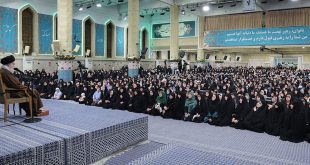Hajj is [a pilgrimage] filled with mysteries and signs that provoke man into deep thought and guide him [back] towards his fitrah (his inner essence and nature).
Therefore it is appropriate that at every step, one pays attention to both the apparent and inner aspects of the Hajj rituals. For the apparent aspect, there are rites with specific rulings that are compulsory to perform; at the same time by pondering over the inner aspect it may be possible to understand some of the philosophy and secrets behind why such mysterious and symbolic actions are performed.
Wearing the Iḥrām is amongst one of the Hajj rituals and putting it on marks the beginning of the Hajj: special clothing for a special type of worship. On an apparent level, some may come to the conclusion that for one of the biggest obligatory [Islamic] rituals, God has ordained for a [type of] dress to be worn which meets certain conditions, i.e., it must be ritually clean and should not be stitched.[1]
A hint of the hidden reasons behind wearing the Iḥrām:
- Iḥrām acts as a test for equality and brotherhood: it serves as a reminder against discrimination; moreover it signifies that man has left the ornamentation of himself together with his attachment to this world and entered into God’s majesty with a pure conscience and unpolluted fitrah.
- Whilst in Iḥrām, kings and paupers are equal: where are the arrogant [powers] to see this astounding exhibition of Muslims from all corners of the earth turning to perform tawaf (circumambulation) of the house of God, to see them all gather together in one land, wearing identical clothing and to see that there is no superiority amongst them except by the degree of taqwa they bear.[2]
- The two parchments of Iḥrām resemble those of the kafan (shroud), furthermore it is recommended (mustahabb)[3] to use one’s Iḥrām as a kafan. Wearing it reminds one of the terrifying moments at the time of death, the difficulties to come after death and the day of Resurrection.
- In the past, present, and future, humans have and will look or dress differently, with different styles. If someone takes advantage of the opportunity to go Hajj, accepting God’s invitation to attend [the pilgrimage] and enter into the ordained holy places whilst wearing Iḥrām, he endeavors [through wearing Iḥrām] to stay aloof from self-glorification or showing off, because wearing the Iḥrām is a sign that he negates the traits of worshiping himself, or egoism.
————————————————————————————————————————————
References
[1] See: Imam Khomeini, Seyed Ruhullah, Manaseke Hajj (annotated), pp. 138-140, Mash’ar Press, Tehran, fourth edition, 1416 AH.
[2] Hujurat:13 (O mankind! Indeed We created you from a male and a female, and made you nations and tribes that you may identify yourselves with one another. Indeed the noblest of you in the sight of Allah is the most God wary among you. Indeed Allah is all-knowing, all-aware).
[3] Imam Khomeini, Seyed Ruhullah, Tahrir al-Wasilah, vol. 1, pg. 75, Dar al-Ilm Institute Press, Qum, first edition, without date.
source:islamquest
 Ijtihad Network Being Wise and Faithful Muslim in the Contemporary World
Ijtihad Network Being Wise and Faithful Muslim in the Contemporary World
